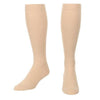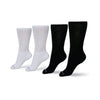Can diabetic socks help with swollen feet

Table Of Contents:
If you or a loved one has diabetes, you may be familiar with the discomfort and complications that come with the condition. One of the most common issues people with diabetes face is swollen feet. But did you know that wearing diabetic socks may help alleviate this symptom? In this article, we'll explore the benefits of diabetic socks for managing swollen feet and how to choose the right pair for your needs.
What are diabetic socks?
Diabetic socks are specially designed socks that are made to reduce the risk of foot complications for people with diabetes. They are typically made from materials that are breathable, moisture-wicking, and non-binding to prevent irritation and promote comfort. They also have added padding and cushioning to protect the feet from pressure and injury.
How can diabetic socks help with swollen feet?
Improved circulation
Swollen feet are often caused by poor circulation, which is a common complication of diabetes. Diabetic socks are designed to improve blood flow to the feet, which can help reduce swelling and other related symptoms. These socks are typically made with graduated compression, which means they are tighter around the ankle and gradually loosen as they go up the leg. This compression helps to promote blood flow and prevent fluid buildup in the feet and legs.
Moisture-wicking properties
Moisture buildup can also contribute to swollen feet in diabetes. Diabetic socks are made with materials that are designed to wick away moisture, keeping the feet dry and comfortable. This can help prevent skin irritation and reduce the risk of infections, which are more common in people with diabetes.
Padding and cushioning
Another benefit of diabetic socks is the added padding and cushioning they provide. This can help protect the feet from pressure and injury, which is especially important for people with diabetes who may have reduced sensation in their feet. The padding and cushioning can also help reduce pain and discomfort associated with swollen feet.
Non-binding design
Traditional socks can be tight around the ankles, which can restrict blood flow and contribute to swelling in the feet. Diabetic socks are designed with a non-binding top that gently conforms to the shape of the leg without constricting it. This can help improve blood flow and reduce swelling in the feet and legs.
Choosing the right diabetic socks
When it comes to choosing diabetic socks, there are a few key factors to consider:
Material considerations
Diabetic socks are typically made from materials that are breathable, moisture-wicking, and non-binding. Look for socks made from natural fibers like cotton or bamboo, as these materials are soft, comfortable, and promote breathability. Avoid synthetic materials like nylon or polyester, which can trap moisture and cause skin irritation.
Compression level
Diabetic socks come in varying levels of compression, ranging from light to extra-firm. The level of compression you need will depend on your individual needs and the severity of your swelling. Consult with your healthcare provider to determine the right compression level for you.
Size and fit
Diabetic socks should fit snugly but not be too tight. Look for socks that come in a range of sizes to ensure the best fit. Avoid socks that are too loose, as they can bunch up and cause irritation.
Brand and product recommendations
There are many brands and products on the market that claim to be "diabetic socks." However, not all socks are created equal. Look for brands that specialize in diabetic socks, as they are more likely to use high-quality materials and offer a variety of styles and sizes. Some popular brands to consider include Diabetic Sock Club, Dr. Comfort, Thorlos, and SmartKnit.
Other ways to manage swollen feet in diabetes
While diabetic socks can be a helpful tool for managing swollen feet in diabetes, they are not the only solution. Here are some other tips to help reduce swelling in the feet and legs:
Maintaining a healthy weight
Excess weight can put added pressure on the feet and legs, which can contribute to swelling. Maintaining a healthy weight through a balanced diet and regular exercise can help reduce swelling and improve circulation.
Elevating the feet
When possible, elevate the feet above heart level to help reduce swelling. This can be done by propping the feet up on pillows or using a footrest. Aim to elevate the feet for at least 30 minutes a day to see benefits.
Staying active
Regular exercise can help improve circulation and reduce swelling in the feet and legs. Aim for at least 30 minutes of moderate exercise, such as walking or swimming, each day. Talk to your healthcare provider before starting any new exercise routine.
Avoiding tight clothing
Tight clothing, such as socks or pants with tight elastic bands, can restrict blood flow and contribute to swelling. Opt for loose-fitting clothing made from breathable materials to promote comfort and circulation.
When to seek medical attention
If you experience persistent or severe swelling in the feet and legs, it's important to seek medical attention. This could be a sign of a more serious condition, such as heart failure or kidney disease. Your healthcare provider can help determine the underlying cause of your swelling and recommend the appropriate treatment.
In conclusion, diabetic socks can be a helpful tool for managing swollen feet in diabetes. They can improve circulation, wick away moisture, provide added padding and cushioning, and have a non-binding design that can reduce swelling. When choosing diabetic socks, it's important to consider the material, compression level, size and fit, and brand. It's also important to incorporate other healthy habits, such as maintaining a healthy weight, staying active, and avoiding tight clothing, to reduce swelling in the feet and legs. If you experience persistent or severe swelling, it's important to seek medical attention. Remember, taking care of your feet is an important part of managing diabetes and maintaining overall health.
If you're interested in trying out diabetic socks for yourself, check out the Diabetic Sock Club. They offer a quiz to help you find the right pair of socks based on your preferences and needs. With a subscription, you'll receive a new pair of socks every month, so you can always have fresh, comfortable socks on hand. Plus, the Diabetic Sock Club offers a satisfaction guarantee, so you can try their socks risk-free. Don't let swollen feet keep you from enjoying life - try out diabetic socks today!
Best Sellers
-
Men's Cotton Diabetic Crew Socks (6 Pair)
![]()
- Regular price
- $39.99
- Sale price
- $39.99
- Regular price
-
$79.95 - Unit price
- per
Sold out





-
Men's Ultra-Soft Upper Calf Diabetic Socks (4 Pair)
![]()
- Regular price
- from $39.99
- Sale price
- from $39.99
- Regular price
-
$79.95 - Unit price
- per
Sold out


-
Men's Cotton Diabetic Ankle Socks (6 Pair)
![]()
- Regular price
- $39.99
- Sale price
- $39.99
- Regular price
-
$69.95 - Unit price
- per
Sold out


-
Women's Cotton Diabetic Crew Socks (6 Pair)
![]()
- Regular price
- $39.99
- Sale price
- $39.99
- Regular price
-
$79.95 - Unit price
- per
Sold out




-
Women's Cotton Diabetic Ankle Socks (6 Pair)
![]()
- Regular price
- $39.99
- Sale price
- $39.99
- Regular price
-
$79.95 - Unit price
- per
Sold out


-
Men's Over The Calf Compression Stocking Socks (1 Pair)
![]()
- Regular price
- from $19.99
- Sale price
- from $19.99
- Regular price
-
$31.95 - Unit price
- per
Sold out





-
Women's Ultra-Soft Upper Calf Diabetic Socks (4 Pair)
![]()
- Regular price
- from $39.99
- Sale price
- from $39.99
- Regular price
-
$79.95 - Unit price
- per
Sold out


-
DSC Hemp Cream For Neuropathy Aches & Nerve Pain (Peppermint)
![]()
- Regular price
- from $39.99
- Sale price
- from $39.99
- Regular price
-
$59.95 - Unit price
- per
Sold out









